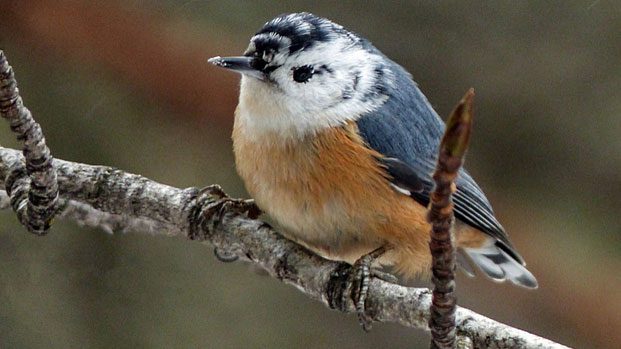What Do You Call The White Skin Around A Parrot's Eyes?

Birds can prove color variations for different reasons. This Ruby-red-breasted Nuthatch has a condition called leucism. Photo by Anne Elliott via Birdshare.

Some private birds may look quite different than they announced in field guides. Often, in that location'due south a very simple reason behind this: the bird is molting. For instance, when American Goldfinch molt betwixt their showy spring and summer feather and their more drab wintertime plumage, they can look very unusual during the transition flow. Only birds, like other animals, can besides showroom naturally occurring color and pigment variations that can brand ID difficult. For example:
- Albinism results from a genetic mutation that interferes with product of the pigment melanin. Unlike humans, animals without melanin may accept other pigments, so they may still take some color. This means that a "true albino" bird may not necessarily be all white, and plumage patterns typical of the species, such as a mask or wingbars, may remain detectable. Truthful albino birds are rare in nature because without protective pigments in the eyes, they may quickly become blind. Besides, feathers wear out more quickly without pigments to provide structural support. Albinism may besides exist referred to as amelanism. Note, when you DO meet a completely white animal with a lack of pigment everywhere—optics, skin, hair, scales, and feathers—this may exist due to a combination of albinism and other paint defects (encounter below). These animals are mostly referred to as "albino," only that may not accurately describe the genetics behind their appearance.
- Partial albinos are much more common, and about birders eventually meet at least a few of these individuals. The term partial albino describes a bird that is paler than normal, or a bird with irregular patches of pure white feathers. There are several different causes of partial albinism—it can be genetic, occur during evolution, happen as birds historic period, or after injury when new feathers lack pigments—and it is a useful general term every bit it tin be impossible to determine why a bird is showing pale plumage without a genetic analysis. Birds with partial albinism may retain plumage patterns typical of the species, such as a mask or wingbars. Here are some reasons animals show partial albinism:
- Hypomelanism is a genetic mutation that causes a fractional lack of melanin. A hypomelanistic bird will be paler than normal where melanin is expressed in the plumage.
- Leucism is not a genetic mutation, merely rather describes defects in pigment cells that are acquired during evolution. This may issue in full leucism, where there is a reduction in all types of pigment. An animal with full leucism will announced paler than normal. Leucistic animals may also show irregular patches of white—this is referred to as fractional leucism, and these animals are often referred to as "pied" or "piebald." Because the development of the eyes occurs separately from other areas of the body, eye color in leucistic animals is not affected and will be normal in color.
- Sometimes with age or afterwards an injury, white patches will appear on an animal. A feather may regrow after an injury and lack pigment. This will give the animal a partial leucistic advent.
- Melanism causes birds to have an excess of night pigmentation and is mostly caused by a genetic mutation, merely tin also exist a issue of certain diets. Some species have a naturally occurring melanic class (or "morph"), such equally the Red-tailed Hawk.
- Xanthochroism is a condition where individual birds of a given species may accept yellowish or orange plumage instead of red. This may be acquired by a genetic variation or past diet. House Finches are often reported as exhibiting xanthrochroism.
- Erythrism is condition where some individuals announced more ruby-red or rufous than others of their kind. For example, Eastern Screech-Owl and Ruffed Grouse oftentimes brandish erythrism and have commonly occurring rufous individuals. This condition is besides caused by a genetic mutation or past nutrition.
If you recollect that you see an private of a certain species, only the color isn't quite "right," keep these variations in listen and recall that size, shape, and beliefs often help to identify a bird fifty-fifty when its feather looks odd. Comparing the shape of a strange bird with other birds nearby can be very helpful equally individuals frequently flock with others of their species.
Visit FeederWatch'south Unusual Birds page to learn more than nigh color variations in birds.

All About Birds is a gratis resource
Available for everyone,
funded by donors like you
Source: https://www.allaboutbirds.org/news/what-can-cause-birds-to-show-weird-color-variations-such-as-being-all-or-partly-white-or-unusually-dark/
Posted by: richardsheith1954.blogspot.com

0 Response to "What Do You Call The White Skin Around A Parrot's Eyes?"
Post a Comment